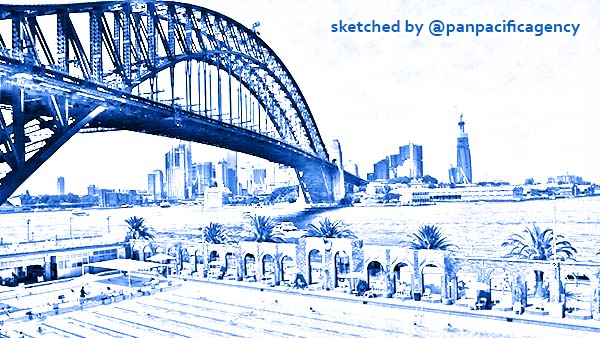Prolonged Sydney lockdown could tip Australia into another recession: Economists

North Sydney Olympic Pool is set reopen pending an engineering review. Photo: AAP. Sketched by the Pan Pacific Agency.
SYDNEY, Jul 29, 2021, The Guardian. Australia may tip into its second recession in as many years if Sydney is unable to get out of lockdown quickly or there is another major Covid-19 outbreak elsewhere in the country, economists say, The Guardian reported.
A 30-year record of growth was shattered last year when Australia fell into a technical recession – two consecutive quarters of the economy shrinking – as coronavirus restrictions crippled many businesses.
The Morrison government’s $90bn jobkeeper wage subsidy scheme helped cushion the blow and as restrictions lifted the economy roared back to life.
But the economic recovery is now threatened by Sydney’s coronavirus lockdown, which premier Gladys Berejiklian strengthened on Thursday as NSW hit a record of 239 new Covid-19 cases, up from 177 on Wednesday.
On Wednesday, Berejiklian extended the lockdown, which had already been running five weeks, by another month, but Commonwealth Bank chief economist Gareth Aird said he expected significant restrictions to remain in place until 80% of the population was vaccinated, in late October at the earliest.
As a result of the lockdown, economists expect growth in GDP for the three months to the end of September to be negative, but are divided about whether the December quarter could also see a fall.
The Morrison government has increased financial support to workers and businesses hit by the Sydney shutdown, after resisting similar aid during lockdowns in Melbourne, but has stopped short of reintroducing jobkeeper.
Appearing on ABC TV on Thursday morning, the treasurer, Josh Frydenberg, said it was “too early to be definite about the December quarter”.
“My expectation is that the September quarter will be negative,” he said.
“But with respect to the December quarter, that does depend to a large extent how successful NSW, our largest state economy, is in getting on top of this virus.”
He said it was also important for the economy that South Australia and Victoria this week came out of lockdowns imposed to combat the Delta variant of Covid-19 currently ravaging NSW.
“If we get on top of this virus, I am confident that the economy will bounce back strong,” he said.
Aird said he didn’t think Australia would fall into technical recession because economic growth in NSW, which is about 32% of the national economy, had been smashed so hard by the Sydney lockdown that even opening up a little would mean figures for December rebounded.
“I think the problem of all this is the rigidity of looking at a recession as being two negative quarters of GDP,” he said. “Try telling people in NSW they’re not in a recession right now.”
He predicts GDP will fall by 2.7% in the September quarter, before rising 1.9% in the three months to the end of the year – an increase that he points out would not make up the losses incurred in the previous three months.
Sarah Hunter, the chief economist at BIS Oxford Economics, said that “a recession is a definite possibility”.
She said that to avoid recession NSW will need to be able to ease restrictions, including restarting construction in local government areas where it is currently banned and allowing some reopening of retail and hospitality.
“The treasurer’s right to note that what happens in NSW will be critical, and there is also a material risk that other states see outbreaks of the Delta variant that could push them back into lockdown [which then knocks back the economy],” she said.
Harley Dale, chief economist at CreditorWatch, which monitors payment flows and corporate distress, said speculation about a double recession was “getting ahead of ourselves” and it was too early to forecast what would happen in the December quarter.
“That’s not to say we’re not at risk of a double recession – it is a real possibility,” he said.
“We must watch key indicators closely over the coming months, such as the employment rate and GDP figures, to see if these risks escalate further.”